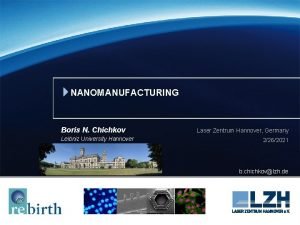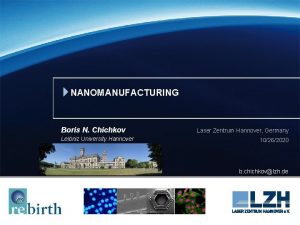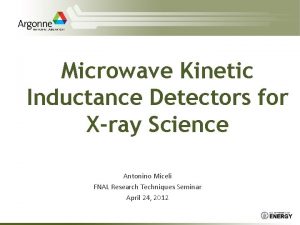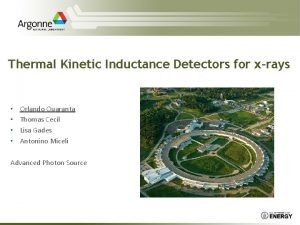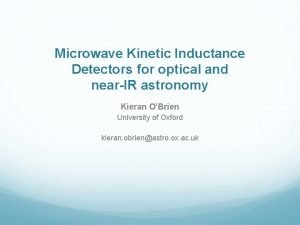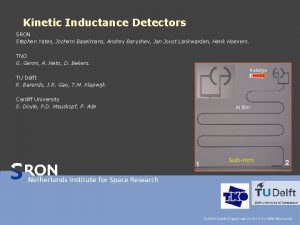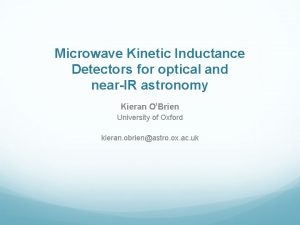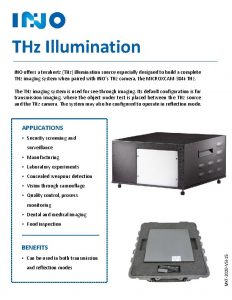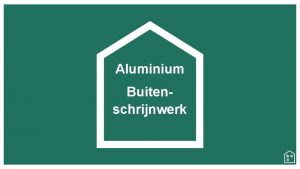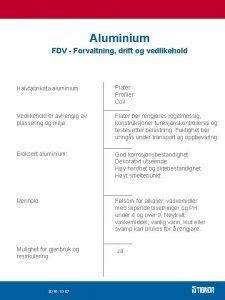Aluminium Kinetic Inductance Detectors at 1 54 THz














- Slides: 14

Aluminium Kinetic Inductance Detectors at 1. 54 THz limited by photon noise and generation-recombination noise Pieter de Visser, Jochem Baselmans, Juan Bueno, Nuria Llombart, Teun Klapwijk SRON TU Delft, Faculty of Applied Sciences TU Delft, Faculty of Electrical Engineering Mathematics and Computer Siences

Optical Noise Equivalent Power @ 1. 54 THz GR - Noise Photon Noise

Operation principle Cooper Pairs 2Δ h Quasiparticles Photons break Cooper pairs => quasiparticles Higher resistance and kinetic inductance Dip depth / amplitude: resistance Resonant frequency / phase: inductance Day et al, Nature 425, 817 (2003)

Anticipated fundamental limits KID is a pair breaking detector: fluctuations in the quasiparticle number • Photon noise (= generation noise) • Recombination noise • Generation-recombination noise Prediction from dark experiments: NEP of 2 x 10 -19 W/Hz 1/2 limited by the presence of excess quasiparticles

Design All Aluminium KID • Central Line: 50 nm Al • Groundplane: 100 nm Al • Halfwave resonator with isolated central strip • X-slot Antenna, broad band around 1. 54 THz • 2 mm silicon elliptical lenses Design suitable for higher frequencies >1. 54 THz

Controlled optical setup 8 optical filters! J. Bueno, Poster 106 (Thursday) Box-in-box setup Baselmans et al. JLTP 167, 360 (2012)

Large range in optical power

Fundamental limit: Photon Noise Random arrival rate of the optical photons + recombination noise Optical Power (f. W)

Generation-recombination noise Quasiparticle fluctuations De Visser et al. PRL 106, 167004 (2011) Wilson & Prober, PRL, 87, 067004 (2001)

Optical Noise Equivalent Power GR - Noise Photon noise limited NEP => Measure of optical efficiency: 48%

Optical responsivity + lifetime: Microwave readout power dependent De Visser et al. APL 100, 162601 (2012) Goldie, Su. ST, 26, 015004 (2013)

Microwave readout power: Excess quasipartilces AND nonlinear reponse due to redistribution of quasiparticles ar. Xiv: 1306. 4992 Poster 104 (Monday)

Summary • Kinetic Inductance Detector at 1. 54 THz – Fundamental noise sources for pair breaking detectors revealed: • Photon noise limited • Generation-recombination noise => excess quasiparticles – NEP 3. 8 x 10 -19 W/Hz 1/2, 48% optical efficiency • Well controlled optical setup, large power range 1. 54 THz experiment - ar. Xiv: 1306. 4238 Microwave response - ar. Xiv: 1306. 4992

KID at 1. 54 THz Optical efficiency: 48% GR - Noise Photon Noise ar. Xiv: 1306. 4238
 Boris chichkov
Boris chichkov Boris laser
Boris laser Nuclear detectors
Nuclear detectors Feature detectors
Feature detectors Streaming current
Streaming current Where are feature detectors located
Where are feature detectors located Adsorption chromatography
Adsorption chromatography Frontier detectors for frontier physics
Frontier detectors for frontier physics Vhv voltage detectors
Vhv voltage detectors Kinesthesis and vestibular sense
Kinesthesis and vestibular sense Gravitational wave detectors hear murmurs from
Gravitational wave detectors hear murmurs from Giant wave detectors murmurs universe
Giant wave detectors murmurs universe Diagnosing error in object detectors
Diagnosing error in object detectors Photo detectors
Photo detectors Feature vectors
Feature vectors
